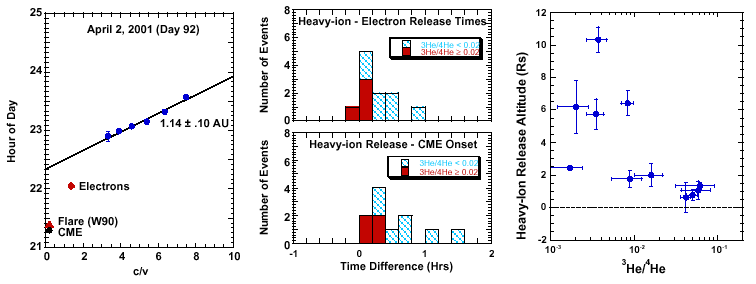
| ACE News Archives | ACE News #72 - June 10, 2003 |
ACE News Archives |

Following an explosive event on the Sun, such as a coronal mass ejection (CME) or solar flare, the higher-velocity solar energetic particles (SEPs) with small pitch angles generally arrive first at 1 AU. This "velocity-dispersion" phenomenon is often used to infer when SEPs were first released into interplanetary space near the Sun, by assuming a common release time for particles of all energies and fitting the arrival times vs. c/v, where v is particle velocity and c is the speed of light. Haggerty and Roelof (ACE News #53) measured the onsets of beam-like near-relativistic electron events with the ACE/EPAM instrument. They found that electrons were typically released ~10 minutes after soft x-ray, optical flare, and associated radio emission. In addition, the electron injections were well associated with western-hemisphere CMEs, with the electrons typically released when the CME was ~1 to ~4 solar radii (Rs) from the solar surface. From the EPAM list of beam-like electron events we identified eleven events suitable for measuring the intensity of 6 to 88 MeV/nuc Z >= 6 ions with ACE/SIS. Particle velocity was determined from the measured mass and energy of each ion. Heavy-ion onsets were identified in up to 8 velocity intervals, and least-squares fits gave the pathlength (typically ~1.2 AU, the Parker spiral distance) and heavy-ion release time near the Sun.
In the example (upper left Figure) the electron release is ~30 minutes after the CME launch and the heavy-ion release is an additional ~30 minutes after that of the electrons. The upper center Figure shows the distribution of delays between the electron and the heavy-ion releases. All eleven of these events were associated with fast CMEs. The histogram in the lower center Figure presents the distribution of heavy-ion release delays after the CME launch from the solar surface. In both histograms the events are separated into two classes based on the 3He/4He ratio measured by SIS at ~10 MeV/nucleon, dividing the events at 3He/4He = 0.02. Assuming that particles are accelerated at the leading edge of the CME, their release altitude can be estimated using SOHO CME data. The right hand Figure shows that the four events with 3He/4He > 0.02 were all released below 2 Rs. We conclude that (a) those events with 3He/4He > 0.02 all have similar ion and electron release times, and appear to be accelerated within <2 Rs of the solar surface, while (b) those with 3He/4He < 0.02 have greater ion-electron timing differences, and appear to be accelerated at ~2 to ~10 Rs from the Sun.
This striking partition of the events into two groups provides new clues as to where and how electrons, ions, and the rare isotope 3He are accelerated in SEP events. We are now investigating the possible roles of CME-driven shocks and impulsive solar flares in producing the rather wide range of differences in the electron and heavy-ion release times.
Submitted by R. A. Mewaldt, C. M. S. Cohen, R. A. Leske and R. C. Ogliore (Caltech), E. C. Roelof and D. K. Haggerty (APL), and M. E. Wiedenbeck (JPL).
Last modified 10 June 2003, by